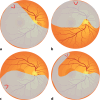A review of rhegmatogenous retinal detachment: past, present and future
- PMID: 40183886
- PMCID: PMC12031774
- DOI: 10.1007/s10354-025-01085-9
A review of rhegmatogenous retinal detachment: past, present and future
Abstract
Retinal detachments are ophthalmic emergencies given their potential to become a permanently blinding disorder if left untreated. This review will outline the history, pathogenesis, clinical presentation, and current and future management of retinal detachments.
Keywords: History; Management; Pathogenesis; Pneumatic retinopexy; Vitrectomy.
© 2025. The Author(s).
Conflict of interest statement
Conflict of interest: J. Xiong, T. Tran, S.M. Waldstein and A.T. Fung declare that they have no competing interests.
Figures














Similar articles
-
Pneumatic Retinopexy in Dialysis-Associated Rhegmatogenous Retinal Detachments.Ophthalmol Retina. 2023 Jan;7(1):92-94. doi: 10.1016/j.oret.2022.09.003. Epub 2022 Sep 21. Ophthalmol Retina. 2023. PMID: 36152984 No abstract available.
-
Pneumatic retinopexy, scleral buckling, and vitrectomy surgery in the management of pseudophakic retinal detachments.Can J Ophthalmol. 2008 Feb;43(1):65-72. doi: 10.3129/i07-196. Can J Ophthalmol. 2008. PMID: 18204500
-
Quality of Life after Pars Plana Vitrectomy, Scleral Buckle, or Pneumatic Retinopexy for Rhegmatogenous Retinal Detachment: A Meta-Analysis.Curr Eye Res. 2024 Mar;49(3):295-302. doi: 10.1080/02713683.2023.2280440. Epub 2023 Nov 20. Curr Eye Res. 2024. PMID: 37937863
-
[Guidelines for surgery in the treatment of rhegmatogenous detachments (buckle, pneumatic retinopexy, endosurgery)].Klin Monbl Augenheilkd. 2004 Mar;221(3):160-74. doi: 10.1055/s-2004-812722. Klin Monbl Augenheilkd. 2004. PMID: 15052521 Review. German.
-
Pneumatic retinopexy: A critical reappraisal.Surv Ophthalmol. 2021 Jul-Aug;66(4):585-593. doi: 10.1016/j.survophthal.2020.12.007. Epub 2020 Dec 24. Surv Ophthalmol. 2021. PMID: 33359545 Review.
References
-
- Wolfensberger TJJ. Jules Gonin. Pioneer of retinal detachment surgery. Indian J Ophthalmol. 2003;51(4):303–8. - PubMed
-
- Gonin J. The treatment of detached retina by searing the retinal tears. Arch Ophthalmol. 1930;4(5):621–5.
-
- Brinton DA, Wilkinson CP. Retinal detachment: principles and practice. 3rd ed. Ophthalmology monographs. New York: Oxford University Press; 2009.
-
- Kunikata H, Abe T, Nakazawa T. Historical, current and future approaches to surgery for rhegmatogenous retinal detachment. Tohoku J Exp Med. 2019;248(3):159–68. - PubMed
Publication types
MeSH terms
LinkOut - more resources
Full Text Sources
Medical
Miscellaneous

